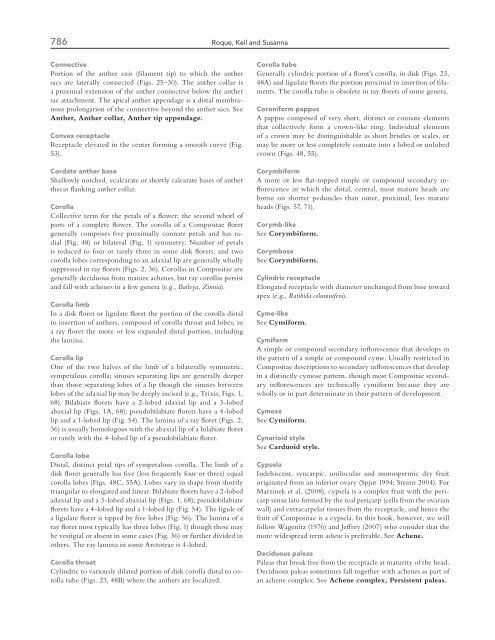Illustrated glossary of Compositae
Illustrated glossary of Compositae
Illustrated glossary of Compositae
You also want an ePaper? Increase the reach of your titles
YUMPU automatically turns print PDFs into web optimized ePapers that Google loves.
786<br />
Connective<br />
Portion <strong>of</strong> the anther axis (fi lament tip) to which the anther<br />
sacs are laterally connected (Figs. 25–30). The anther collar is<br />
a proximal extension <strong>of</strong> the anther connective below the anther<br />
sac attachment. The apical anther appendage is a distal membranous<br />
prolongation <strong>of</strong> the connective beyond the anther sacs. See<br />
Anther, Anther collar, Anther tip appendage.<br />
Convex receptacle<br />
Receptacle elevated in the center forming a smooth curve (Fig.<br />
53).<br />
Cordate anther base<br />
Shallowly notched, ecalcarate or shortly calcarate bases <strong>of</strong> anther<br />
thecas fl anking anther collar.<br />
Corolla<br />
Collective term for the petals <strong>of</strong> a fl ower; the second whorl <strong>of</strong><br />
parts <strong>of</strong> a complete fl ower. The corolla <strong>of</strong> a <strong>Compositae</strong> fl oret<br />
generally comprises fi ve proximally connate petals and has radial<br />
(Fig. 48) or bilateral (Fig. 1) symmetry. Number <strong>of</strong> petals<br />
is reduced to four or rarely three in some disk fl orets, and two<br />
corolla lobes corresponding to an adaxial lip are generally wholly<br />
suppressed in ray fl orets (Figs. 2, 36). Corollas in <strong>Compositae</strong> are<br />
generally deciduous from mature achenes, but ray corollas persist<br />
and fall with achenes in a few genera (e.g., Baileya, Zinnia).<br />
Corolla limb<br />
In a disk fl oret or ligulate fl oret the portion <strong>of</strong> the corolla distal<br />
to insertion <strong>of</strong> anthers, composed <strong>of</strong> corolla throat and lobes; in<br />
a ray fl oret the more or less expanded distal portion, including<br />
the lamina.<br />
Corolla lip<br />
One <strong>of</strong> the two halves <strong>of</strong> the limb <strong>of</strong> a bilaterally symmetric,<br />
sympetalous corolla; sinuses separating lips are generally deeper<br />
than those separating lobes <strong>of</strong> a lip though the sinuses between<br />
lobes <strong>of</strong> the adaxial lip may be deeply incised (e.g., Trixis; Figs. 1,<br />
68). Bilabiate fl orets have a 2-lobed adaxial lip and a 3-lobed<br />
abaxial lip (Figs. 1A, 68); pseudobilabiate fl orets have a 4-lobed<br />
lip and a 1-lobed lip (Fig. 54). The lamina <strong>of</strong> a ray fl oret (Figs. 2,<br />
36) is usually homologous with the abaxial lip <strong>of</strong> a bilabiate fl oret<br />
or rarely with the 4-lobed lip <strong>of</strong> a pseudobilabiate fl oret.<br />
Corolla lobe<br />
Distal, distinct petal tips <strong>of</strong> sympetalous corolla. The limb <strong>of</strong> a<br />
disk fl oret generally has fi ve (less frequently four or three) equal<br />
corolla lobes (Figs. 48C, 55A). Lobes vary in shape from shortly<br />
triangular to elongated and linear. Bilabiate fl orets have a 2-lobed<br />
adaxial lip and a 3-lobed abaxial lip (Figs. 1, 68); pseudobilabiate<br />
fl orets have a 4-lobed lip and a 1-lobed lip (Fig. 54). The ligule <strong>of</strong><br />
a ligulate fl oret is tipped by fi ve lobes (Fig. 56). The lamina <strong>of</strong> a<br />
ray fl oret most typically has three lobes (Fig. 1) though these may<br />
be vestigial or absent in some cases (Fig. 36) or further divided in<br />
others. The ray lamina in some Arctoteae is 4-lobed.<br />
Corolla throat<br />
Cylindric to variously dilated portion <strong>of</strong> disk corolla distal to corolla<br />
tube (Figs. 23, 48B) where the anthers are localized.<br />
Roque, Keil and Susanna<br />
Corolla tube<br />
Generally cylindric portion <strong>of</strong> a fl oret’s corolla, in disk (Figs. 23,<br />
48A) and ligulate fl orets the portion proximal to insertion <strong>of</strong> fi laments.<br />
The corolla tube is obsolete in ray fl orets <strong>of</strong> some genera.<br />
Coroniform pappus<br />
A pappus composed <strong>of</strong> very short, distinct or connate elements<br />
that collectively form a crown-like ring. Individual elements<br />
<strong>of</strong> a crown may be distinguishable as short bristles or scales, or<br />
may be more or less completely connate into a lobed or unlobed<br />
crown (Figs. 48, 55).<br />
Corymbiform<br />
A more or less fl at-topped simple or compound secondary infl<br />
orescence in which the distal, central, most mature heads are<br />
borne on shorter peduncles than outer, proximal, less mature<br />
heads (Figs. 57, 71).<br />
Corymb-like<br />
See Corymbiform.<br />
Corymbose<br />
See Corymbiform.<br />
Cylindric receptacle<br />
Elongated receptacle with diameter unchanged from base toward<br />
apex (e.g., Ratibida columnifera).<br />
Cyme-like<br />
See Cymiform.<br />
Cymiform<br />
A simple or compound secondary infl orescence that develops in<br />
the pattern <strong>of</strong> a simple or compound cyme. Usually restricted in<br />
<strong>Compositae</strong> descriptions to secondary infl orescences that develop<br />
in a distinctly cymose pattern, though most <strong>Compositae</strong> secondary<br />
infl orescences are technically cymiform because they are<br />
wholly or in part determinate in their pattern <strong>of</strong> development.<br />
Cymose<br />
See Cymiform.<br />
Cynarioid style<br />
See Carduoid style.<br />
Cypsela<br />
Indehiscent, syncarpic, unilocular and monospermic dry fruit<br />
originated from an inferior ovary (Spjut 1994; Stearn 2004). For<br />
Marzinek et al. (2008), cypsela is a complex fruit with the pericarp<br />
sensu lato formed by the real pericarp (cells from the ovarian<br />
wall) and extracarpelar tissues from the receptacle, and hence the<br />
fruit <strong>of</strong> <strong>Compositae</strong> is a cypsela. In this book, however, we will<br />
follow Wagenitz (1976) and Jeff rey (2007) who consider that the<br />
more widespread term achene is preferable. See Achene.<br />
Deciduous paleas<br />
Paleas that break free from the receptacle at maturity <strong>of</strong> the head.<br />
Deciduous paleas sometimes fall together with achenes as part <strong>of</strong><br />
an achene complex. See Achene complex, Persistent paleas.


